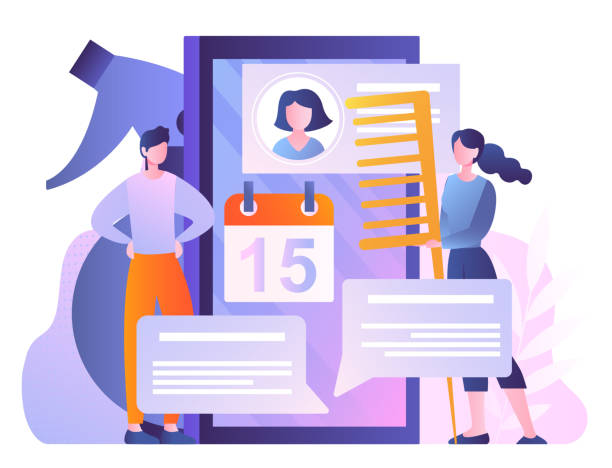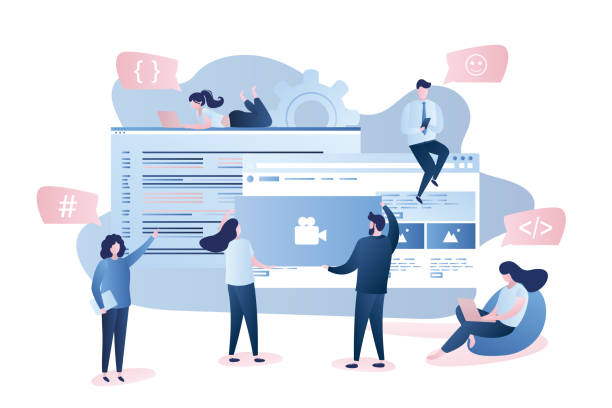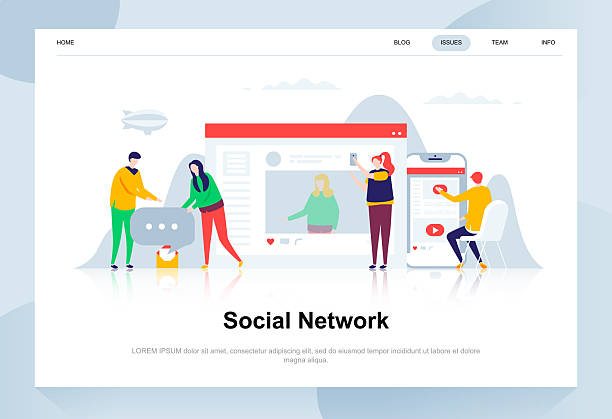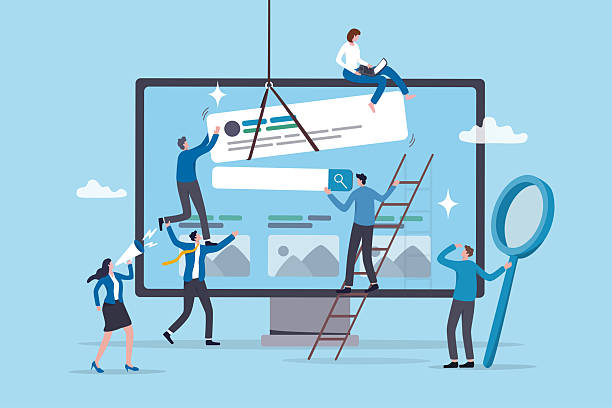The Fundamental Importance of Secure Website Design for Businesses
In today’s world, where the complexities of cyberspace increase daily, secure website design is no longer an option, but an undeniable necessity.
This issue becomes even more critical for businesses that store sensitive user information and financial data on the web.
#Website_security means protecting the website against cyberattacks, data breaches, and unauthorized access.
Failure to adhere to this principle can lead to loss of customer trust, heavy financial losses, and serious damage to brand reputation.
In fact, any security breach can have irreparable consequences for an organization.
This section explains the importance of a preventive approach against cyber threats.
A secure website not only protects your information but also assures users that they can safely use your services.
Investing in website security is an investment in the future and sustainability of your business.
Did you know that customers’ first impression of your company is your website? Multiply your business’s credibility with a powerful corporate website from Rasawob!
✅ Custom and eye-catching design tailored to your brand
✅ Improved user experience and increased customer attraction
⚡ Get a free consultation!
Identifying and Analyzing Common Web Security Threats
To achieve a #secure_website_design, one must first know the enemy.
The web world is full of various threats that lie in wait for websites at any moment.
This analytical section examines the most common and destructive cyberattacks that developers and site administrators should be aware of.
Attacks such as #SQL_Injection, where an attacker extracts sensitive information by injecting malicious code into the database; or #XSS (Cross-Site Scripting), which gains access to user information by injecting malicious scripts into web pages.
#DDoS (Distributed Denial of Service) attacks also make a site unavailable by creating false and heavy traffic.
A deep understanding of these threats and how they work is the first step in effective countermeasures and strengthening website security infrastructures.
Familiarity with these vulnerabilities helps us adopt a more proactive approach to web security and find ways to protect against them.
Continuous analysis of security reports and staying up-to-date with new attack methods are essential for maintaining website security.
Pillars of Web Security: SSL/TLS and Web Application Firewall (WAF)
Two main pillars in #secure_website_design are SSL/TLS certificates and Web Application Firewalls (WAF).
This specialized section delves into these two critical technologies.
SSL/TLS are protocols that encrypt the communication between the user’s browser and the web server, ensuring that transmitted information (such as passwords and banking details) remains confidential and untampered.
The presence of HTTPS in the website address indicates the use of these protocols and builds user trust.
On the other hand, a WAF, or Web Application Firewall, is a protective layer that monitors and filters HTTP traffic before it reaches the web application.
These firewalls can identify and block attacks such as SQL Injection, XSS, and Cross-Site Request Forgery (CSRF).
WAFs play a vital role in protecting against known and unknown vulnerabilities (zero-day exploits) in web applications and are an integral part of any comprehensive web security strategy.
Proper deployment and configuration of these tools are among the main pillars of a secure website, and without them, the website will be vulnerable to many attacks.
| Feature | SSL/TLS | WAF |
|---|---|---|
| Main Purpose | Data Traffic Encryption | Web Application Protection |
| Deployment Location | On the Web Server | In front of the Web Application |
| Type of Protection | Data Confidentiality and Integrity | Prevention of Layer 7 (Application) Attacks |
| Examples of Protected Attacks | Eavesdropping | SQL Injection, XSS, CSRF |
Guide to Best Secure Coding Practices for Developers
The heart of any website is its code, and therefore, #secure_coding is a vital component of #secure_website_design.
This section provides practical guidance for developers to prevent common vulnerabilities in code.
Input Validation is of paramount importance; any data received from the user must be validated and filtered before being used in any part of the system to prevent the injection of malicious code.
Also, using prepared statements in database queries is an effective way to prevent SQL Injection.
Click here to preview your posts with PRO themes ››
Furthermore, outputs should always be encoded (Output Encoding) to prevent XSS attacks.
Not disclosing sensitive information (such as error messages with server details), proper Session Management, and using strong hashing functions to store passwords are other important principles of secure coding.
Developers must continuously update their knowledge in cybersecurity and use Static Application Security Testing (SAST) and Dynamic Application Security Testing (DAST) tools to identify and fix vulnerabilities.
Following these guidelines helps create a strong foundation for website security.
Did you know that customers’ first impression of your company is your website? Multiply your business’s credibility with a powerful corporate website from Rasawob!
✅ Custom and eye-catching design tailored to your brand
✅ Improved user experience and increased customer attraction
⚡ Get a free consultation!
Best Database Security Practices for Secure Websites
The database is the treasure trove of your website’s information, and #database_security is one of the cornerstones of #secure_website_design.
This specialized section examines key principles and methods for protecting your data.
One of the most important principles is the application of the Principle of Least Privilege; meaning that every user or application should only have access to the minimum data and operations necessary to perform its tasks.
This significantly reduces the risk of intrusion and unauthorized access.
Encrypting data, both at rest (on the hard disk) and in transit (over the network), is of paramount importance.
Using secure connections and SSL/TLS for database communication protects information from eavesdropping.
Also, hashing passwords with strong algorithms (such as bcrypt or Argon2) instead of storing them in plain text is essential.
Continuous monitoring of database activities to identify suspicious patterns and installing security updates for database software are other vital measures.
Ensuring database security directly helps protect users’ personal information and maintain your business’s reputation and prevents widespread data breaches.
User Authentication and Access Management in Secure Website Design
#User_authentication and #access_management are vital parts of any #secure_website_design.
This instructional section explains solutions to ensure that only authorized users have access to relevant information and sections.
The use of strong and unique passwords for users should be mandatory, and the system should support password complexity policies (a combination of uppercase and lowercase letters, numbers, and symbols).
Passwords should be stored as hashed and salted to ensure they cannot be recovered even in the event of a database breach.
Implementing Multi-Factor Authentication (MFA), such as sending a code to a mobile phone or email, adds a powerful security layer to the login process.
Also, Session Management should be designed so that sessions expire after a period of inactivity, and session tokens are securely generated and maintained.
Access management systems should be designed based on Role-Based Access Control (RBAC), so that each user only has access to the resources they need for their tasks.
These approaches minimize the risk of unauthorized access and abuse of user accounts and contribute to the stability of website security.
Regular Updates, Monitoring, and Vulnerability Scanning for Continuous Security
The world of cybersecurity is constantly changing, and news of new vulnerabilities is released daily.
To maintain a #secure_website_design, #regular_updates and #security_monitoring are essential.
This news section emphasizes that neglecting these aspects can expose your website to serious risks.
Prompt installation of security updates for the operating system, frameworks, libraries, and plugins used on the website is of paramount importance.
Many attacks exploit known weaknesses that have already been patched.
Click here to preview your posts with PRO themes ››
Furthermore, continuous monitoring of server logs, security logs, and website traffic is essential to identify suspicious activities.
SIEM (Security Information and Event Management) tools can assist in collecting and analyzing these logs.
Regular vulnerability scans and penetration tests by security specialists help identify weaknesses before attackers discover them.
These proactive measures are important steps in maintaining the stability and security of a website and insure your website against new threats.
Staying informed about the latest news, attack methods, and defenses is crucial for maintaining this stability.
| Approach | Description | Importance in Secure Website Design |
|---|---|---|
| Regular Updates | Installing the latest security patches and stable software versions | Covering known vulnerabilities and reducing attack surface |
| Security Monitoring | Monitoring logs and network traffic to identify anomalies | Early detection of attacks and rapid response |
| Vulnerability Scanning | Using tools to identify weaknesses and misconfigurations | Finding security flaws before attackers do |
Backup and Disaster Recovery Strategies for Website Sustainability
Even with the best #secure_website_design approaches, unforeseen incidents such as data loss due to human error, hardware failure, or an advanced cyberattack are always possible.
This section explains the importance of planning for Backup and #Disaster_Recovery.
Having a regular and reliable backup strategy is your last line of defense against permanent data loss.
Backup should include all critical website data, including code files, databases, and server configurations.
These backups should be maintained regularly (daily, weekly) and in secure, separate locations (off the main server, e.g., cloud storage or offline servers).
More important than backing up is having a disaster recovery plan that includes detailed steps to restore the system to an operational state after an incident.
This plan should be tested regularly to ensure its effectiveness.
Without a robust backup and recovery plan, even the most secure websites are vulnerable to disaster, and their sustainability will be at risk.
This proactive approach ensures the continuity of your business in the face of challenges.
Are you losing business opportunities because of an outdated website? With Rasawob, permanently solve the problem of not attracting potential customers through your website!
✅ Attract more high-quality leads
✅ Increase brand credibility in the eyes of customers
⚡ Get a free corporate website design consultation
The Human Element: User Awareness and Training for a Safer Environment
It is often said that the weakest link in the security chain is the human element.
This is particularly true in the context of #secure_website_design.
This section, while engaging, seriously addresses the importance of #user_awareness and #security_training.
Social engineering attacks such as phishing and spear phishing, exploit user ignorance or carelessness to infiltrate systems.
Attackers often prefer to obtain the information they need by tricking users, rather than trying to break complex security systems.
To combat these threats, regular and continuous training for all users (including internal employees and even customers, if necessary) is vital.
These trainings should cover identifying phishing emails, the importance of using strong and unique passwords, not clicking on suspicious links, and reporting unusual activities.
Social engineering training with real-world examples and simulated scenarios can be very effective.
Strengthening the human element through awareness is one of the most cost-effective and efficient ways to increase overall website security and ultimately helps maintain a safer digital environment for everyone.
Future Trends in Web Security and New Horizons for Secure Website Design
The world of web security never stands still, and new challenges and solutions are constantly emerging.
This thought-provoking section explores #future_trends in #web_security and how #secure_website_design will evolve in the coming decades.
Artificial Intelligence (AI) and Machine Learning (ML) will play an increasing role in detecting advanced threats and automating responses to cyberattacks.
These technologies can identify complex attack patterns that remain hidden from human sight.
Click here to preview your posts with PRO themes ››
Blockchain technology may also be used in the future to enhance data security and decentralized authentication.
The concept of ‘Zero Trust’, which emphasizes not trusting any user or device, even within the network, will become a dominant security model.
This model requires continuous verification of identity and access.
New challenges such as #IoT_security and quantum computing, which could render current encryption methods obsolete, are also on the horizon.
Preparing for these changes and investing in emerging technologies is essential for maintaining website security in the future.
These innovative approaches help us remain resilient against unknown and more complex threats and elevate secure website design to higher levels.
Frequently Asked Questions
| No. | Question | Answer |
|---|---|---|
| 1 | What is secure website design? | The process of designing and developing websites that are resistant to cyberattacks and protect user data and privacy. |
| 2 | Why is website security important? | To prevent data breaches, financial losses, damage to company reputation, and maintain user trust. |
| 3 | What are some common website security threats? | SQL Injection, XSS (Cross-Site Scripting), CSRF (Cross-Site Request Forgery), weak authentication, and outdated software. |
| 4 | What is SSL/TLS and what is its role? | Protocols for encrypting data between the user’s browser and the website server, which ensures secure and private communication. |
| 5 | How can SQL Injection attacks be prevented? | By using Prepared Statements/Parameterized Queries, input validation, and ORMs (Object-Relational Mappers). |
| 6 | What is the role of a Web Application Firewall (WAF) in security? | A WAF monitors and filters HTTP traffic between a web application and the internet to prevent malicious attacks. |
| 7 | Why are regular updates of software and libraries necessary? | Updates include patches for known security vulnerabilities that attackers can exploit. |
| 8 | How can XSS attacks be prevented? | By sanitizing and escaping all user inputs before displaying them on the web page and using a Content Security Policy (CSP). |
| 9 | What does the Principle of Least Privilege mean? | It means that users and systems are granted only the minimum necessary permissions to perform their tasks, preventing unnecessary access to resources. |
| 10 | What is the importance of proper user session management? | To prevent session hijacking and unauthorized access to user accounts through secure and expiring session tokens. |
And other services of Rasawob Advertising Agency in the field of advertising
Smart Marketplace: Transform sales growth with customized user experience.
Smart Website Development: Dedicated service for click-through rate increase based on marketing automation.
Smart Data Analysis: A combination of creativity and technology for customer acquisition through custom programming.
Smart Google Ads: Professional optimization for SEO ranking improvement using Google advertising management.
Smart Custom Software: A combination of creativity and technology for analyzing customer behavior through user experience customization.
And over hundreds of other services in the field of internet advertising, advertising consultation, and organizational solutions
Internet Advertising | Advertising Strategy | Advertorials
Resources
Comprehensive WordPress Security GuideWhat is an SSL Certificate and why is it essential for your site?What are DDoS attacks and how to protect your site?10 Key Tips to Increase Website Security
? For the sustainable growth of your business in the digital world, Rasawob Afarin Digital Marketing Agency, with its comprehensive services from secure website design and search engine optimization to targeted advertising campaigns, is always by your side. With Rasawob Afarin, experience a powerful and successful online presence.
📍 Tehran, Mirdamad Street, next to Central Bank, Southern Kazerun Alley, Ramin Alley No. 6














